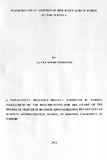| dc.description.abstract | The main objective of this study was to establish the determinants of adoption of risk based audit in public sector in Kenya. For many years, auditing was confined to assisting organizations to safeguard assets and check established control procedures with the main focus being monitoring and control. Internal auditors on the other hand are tolerated, and have not been deemed essential in organizational control. The emergence of new business risks has compelled many organizations to formulate strategies and to elevate the status of internal auditing. Although a shift of internal audit from system based to risk based has been embraced widely with the developed countries taking the lead, prior internal audit research has explored objectivity issues. . The research design that was used in this study was both cross sectional and descriptive survey method aimed at establishing the determinants of adoption of risk based audit approach in the public sector in Kenya. The data was collected using a self-administered questionnaire. Data was collected from 60 respondents which constitute a responce rate of 89.5% which was sufficiently representative of the target populutaion. The study found out that risk based audit is seen to be a complex process which tends to extend over a number of years for its successful implementation and it therefore calls for careful design, sequencing and implementation. Findings showed that Risk based audit enhances transparency, accountability and responsiveness to public expenditure policy priorities and it virtually cover all aspects of public financial management. The study concludes that Risk based audit was determined by the role of internal audit function, top management commitment, training, policy framework and communication. However there were some other vital determinants that were not part of the study as confirmed by the fishers fitness test.The results of the test depicted the regression model as not significant for the study because F was found to be .815 with a significance level of .544. | en |

